
Philippine Defense Today (Adroth.ph)
In Defense of the Republic of the PhilippinesA role for seaplanes in the Armed Forces of the Philippines
Saturday , 8, August 2015 AFP modernization, Philippine Air Force, Philippine Navy Leave a commentSeaplanes and flying boats are aircraft with the unique ability to travel to any marine destination, at fixed-wing-aircraft speed, and then land and take-off from water. It is a category of aircraft that is — theoretically — well suited to an archipelagic country like the Philippines.
The Philippine Navy’s 15-year development plan calls for the acquisition of eight (8) Amphibious Maritime Patrol Aircraft. More recently, the Philippine Air Forces issued a P2.6B invitation to bid for three Search and Rescue seaplanes in November 2013. Both acquisitions, however, are currently on-hold. This suggests that while the Armed Forces of the Philippines (AFP) recognizes the value of this category of aircraft, they are not particularly high in the priority list. Which is unfortunate given the unique missions that only they can perform.
In this article, let us explore this category of aircraft, the different sub-categories within, their operational challenges, and the roles they play.
Seaplanes, flying boats, atbp.
The term “seaplane” is often used to describe all planes that take off and land on water. But this really only correctly describes one type of machine.
Seaplanes have floats beneath their aircraft upon which they land on water. The floats serve as their landing gear, and are typically permanently suspended beneath the plane. This aerodynamic penalty is the price paid for marine operation.
Flying boats, on the other-hand, have specially designed fuselages designed to operate in water. This makes for an aerodynamically clean fuselage. Some designs have additional floats on the wings to keep the plane upright in the water, while others have specially designed extensions that serve this purpose.
“Amphibians” are a sub-category of flying boat that land on water exclusively, and only use their landing gear to taxi from water on to land. On paper, this is the type of aircraft that the Philippine Navy is eyeing. Lack of clarity about the Authorized Budget for Contract that will be allocated to the project makes it difficult to predict the outcome of the project.
The Armed Forces of the Philippines has operated both seaplanes and flying boats over the years, but have since retired them.
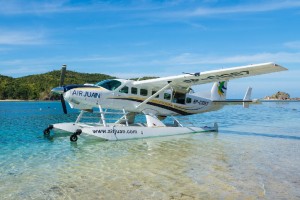 |
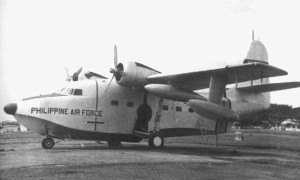 |
|
| Cessna Grand Caravan seaplane. Photo c/0 Air Juan Website |
PAF HU-16 Albatross Flying boat |
In the early 20th century, when limitations on aircraft endurance necessitated more refueling stops than there were aerodromes, flying boats like the PanAm Clippers were the only way to fly, for example, from San Francisco to Manila. This could be done by way of water landings at Honolulu, Midway, Wake, and Guam. The path they took appears in the map below, taken from the Website clipperflyingboats.com.
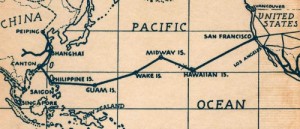 |
| Photo c/o clipperflyingboats.com |
Advances in aviation design have since made it possible to fly previously unimaginable distances without refueling. Today Philippine Airlines regularly flies the San Francisco to Manila route via direct 13-hour flights.
Since World War II, seaplanes and flying boats have been relegated to specialized roles, and only by a drastically reduced number of countries. Early champions of the aircraft type, the United States and the United Kingdom, have all retired their floatplanes without replacements. Japan, Russia, and Canada are the only remaining players in the military / government flying boat market. Other manufacturers, like Cessna and Dornier, are mainly aimed at the civilian market which focus on light aircraft for niche applications.
The reasons for this decline are multi-faceted and are beyond the scope of this article. But among them are the challenges inherent to this aircraft type.
Operating seaplanes
The book Corsairville: The lost domain of the flying boat by Graham Coster is a travel book that sought the story behind a British flying boat that crashed in the Belgian Congo. As part of that exploration, the author chronicled the changing attitudes towards seaplanes and flying boats. It contained numerous interesting insights into the challenges of operating seaplanes, which could be summarized as follows:
- Salt vs aluminum
- Water landings
- Foreign Object Damage concerns
Salt vs aluminum
Salt water is corrosive. This is obvious to anyone who’s been on a ship or frequents the coasts. While marine aluminum is more corrosion resistant than steel (corrosion rate of 1mm/year versus 120mm, see here), corrosion still occurs. This necessitates measures to combat this phenomena.
The following quotes from the book directly reference this issue. Note that “Seaplane” and “Pan-Am Air Bridge” were seaplane operators that the author used for his research into seaplane operations.
A floatplane did little more that dip its toes in on each landing, but at the end of everyday, Seaplane‘s Cessna had the hose turned on it for an hour and a half.
. . .
Two out of Pan-Am Air Bridge’s (aka Chalk’s Ocean Airways) 5 Mallards needed work . . . That insinuating, continuously destructive, salt again: everyday they had to run fresh water through the airframes, wash down the hull, apply all kinds of preservatives, coat rivet lines and joins with grease. ‘For every hour we fly’ . . . your going to take 3 to 4 hours of maintenance.
Philippine aircraft operators are no strangers to salt. With a significant portion or all airports and airfields being close to the sea, and salty sea spray, measures to control the build-up of this corrosive substance, ideally, ought to be common place knowledge. However, an aircraft that deliberately makes contact with salt water will require additional attention to ensure longevity.
Water landings
Whereas salt water’s effects on the seaplane’s airframe presented what amounts to an inconvenience to its maintainers and the organization that operates them, the floatplane’s operating environment presents challenges for its pilot.
The book presented insights from a former Sunderland pilot. The Sunderland is a British flying boat shown blow. This particular photo shows an Australian example of the aircraft.
 |
Here are the pilot’s thoughts about the idiosyncracies of floatplane flight:
For a take-off, once you were out on the water, everything was variable. ‘It won’t just sit on the runway — it’ll roll — so the wings won’t stay level: you have to use the ailerons. Then, because of the torque of the engines, it’ll swing: you have to use the rudder to keep it straight’. Because the swing was habitually to port, you opened up the port engines first, and built up speed to 50, 60 knots until the flying boat’s 5-foot draught was out of the water and the craft was planing on its step . . .
The variability of the landing surface also requires an additional skill for pilots: “reading the water”. The following excerpt from the book illustrates this skill, c/o an interview with an Alaskan seaplane pilot.
See those black spots in the water?’ They were like scuffmarks, bruise-shadows in the indigo bay. ‘That’s where the wind is denting the water — coming down over this mountain and kind of bouncing off it’. Cat’s paws was the aviator’s nickname for them, because they also looked like a scatter of prints: the sight of them warned you that as you descended below that mountain the gusts could knock you about. Over east in the next bay . . . the water was fish-scaled silver . . . like silver-thread cloth, but said Fred, that fish-scaling was the wind whipping up the water. Try to land near that and both descent and touchdown would be a lot rougher. ‘We learn to read the water.’
The Federal Aviation Authority’s seaplane manual highlights the conditions that pilots have to “read”:
While a land plane pilot can rely on windsocks and indicators adjacent to the runway, a seaplane pilot needs to be able to read wind direction and speed from the water itself. On the other hand, the landplane pilot may be restricted to operating in a certain direction because of the orientation of the runway, while the seaplane pilot can usually choose a takeoff or landing direction directly into the wind.
Even relatively small waves and swell can complicate seaplane operations. Takeoffs on rough water can subject the floats to hard pounding as they strike consecutive wave crests. Operating on the surface in rough conditions exposes the seaplane to forces that can potentially cause damage or, in some cases, overturn the seaplane. When a swell is not aligned with the wind, the pilot must weigh the dangers posed by the swell against limited crosswind capability, as well as pilot experience.
While landing gears provide some level of forgiveness during hard landings, such landings for a flying boat have serious consequences, as shown in this excerpt from Corsairville:
Ken Emmott had once had to swim for it . . in Southampton Water when his BOAC captain had landed too fast, bounced their Sunderland off the water and cut away a large section of the nose before they sank to the bottom.
The Federal Aviation Authoriy’s seaplane manual affirms the plane’s sensitivity to hard landings
Because floats are mounted rigidly to the structure of the fuselage, they provide no shock absorbing function, unlike the landing gear of landplanes. While water may seem soft and yielding, damaging forces and shocks can be transmitted directly through the floats and struts to the basic structure of the airplane.
Foreign Object Damage concerns
The unique handling characteristics of seaplanes and flying boats require specialized training and flight experience. But there is one issue that no amount of flight training can completely address: debris.
The FAA seaplane manual offers the following guideline for seaplane landings:
It is usually a good practice to circle the area of intended landing and examine it thoroughly for obstructions such as pilings or floating debris, and to note the direction of movement of any boats that may be in or moving toward the intended landing site. Even if the boats themselves will remain clear of the landing area, look for wakes that could create hazardous swells if they move into the touchdown zone.
Ocular surveys from the air, however, can only go so far. As Iren Dornier and his crew demonstrated spectacularly at an Austrian airshow in Salzkammergut in July 2015.
Dornier, the pilot, is the grandson of the German Aviation Pioneer Dr. Claude Dornier and has significant investments in the Philippines to include South East Asian Airlines (SEAir) and a flying boat factory at the former Clark AFB in Pampanga, where his company manufactures the S-Ray 007 amphibian. He and his crew had been flying their refurbished World War 2-era DO 24ATT flying boat as part of a round-the-world tour to raise funds for the UNICEF, and were thus experienced flying boat operators. His floatplane credentials and lineage are impressive. That, however, did not make him or his crew them immune to floating debris.
The following photographs show what happens if a flying boat makes contact with unseen floating debris (believed to be a tree trunk) during landing. The object tore a fist-sized hole in the side of the DO 24ATT flying boat, which then took on water. The plane had to be towed to shore. None of the crew were injured.
 |
 |
|
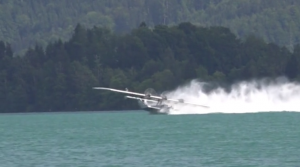 |
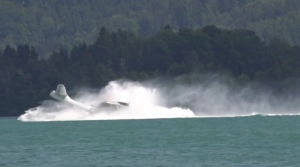 |
|
 |
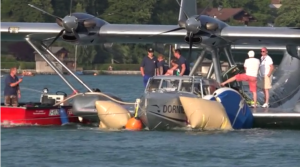 |
Video of the event available below
Given the amount of debris in Philippine water ways, from flood water run-off, garbage thrown off ships, and cast-offs of various marine economic activities, the probability of similar contact is not insignificant
Bodies of water are constantly changing. Even if a seaplane were to take off and land from the same location. The condition of that landing point will never be same as it was when the plane took off from it. What was safe when the pilot left it, might not be so upon return. It is that variability that increases the uncertainty.
Seaplanes alternatives
Arguably, one contributory factor to the decline of the seaplanes and and flying boats was the rise of the helicopter. It replaced the floatplane as the preferred platform for non-aircraft-carrier-based aerial missions. Seaplanes used to perform reconnaissance, liaison, and search and rescue missions from ships large enough to accommodate them.
In World War II, some vessels could launch their planes using catapaults. However to recover them, the ship had to stop to bring the plane back onboard — a risky and time consuming maneuver. If the sea state around the recovering ship was unfavorable, landing alongside the recovery ship would be impossible.
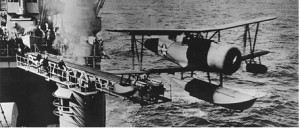 |
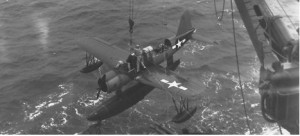 |
|
| Catapault launch photo c/o Pacificaviationmuseum.org | Seaplane recovery photo c/o Pacificaviationmuseum.org |
Helicopters on the other hand could land on ships while underway, and in a broad range of sea states. They could also rescue individuals in the water, without needing to risk the aircraft in a water landing, by hovering above them and lowering a rescue winch.
Long range maritime patrol missions have also been traditional fixtures the flying boat’s offerings. The same qualities that made floatplanes the principal means of air travel across the Pacific, also made them the ideal maritime patrol aircraft for their time. Their ability to take off from water meant that they could be based closer to the intended patrol area without needing runways, and could be refueled and re-provisioned by ship.
However advances in aviation technology have given conventional land-based aircraft the range and reliability to perform such missions, all from the safety of a non-variable runway . Furthermore, land-based aircraft do not require the aerodynamic compromises imposed by water landing requirements (e.g., floats and associated struts, etc.) thus improving performance.
Air forces simply no longer needed flying boats for the bulk of their traditional missions. But . . . not all.
Flying boats, and to a large extent seaplanes, retain the advantage of speed over helicopters. Whereas a relatively slow World War II flying boat like a PBY Catalina only flies at 189 mph, the Philippine Navy’s newest multipurpose helicopter, the AgustaWestland AW109 only had a maximum cruising speed of 177 mph. That speed advantage is a key differentiator.
 |
 |
|
| PAF PBY Catalina photo c/o Francis Neri Albums | AW109 photo c/o Philippine Navy |
Justifying the risk
Water take off and landings compound the dangers already inherent in flying. If a helicopter or a conventional plane can do the mission better and safer, then the suitability of a floatplane for that task is debatable. However, there are specific missions that only seaplanes and flying boats are able to perform. These are unique requirements that justify their expense, both in pilot training and additional maintenance for the aircraft, as well as the risk inherent to operating from water.
No place in the Republic of the Philippines better illustrates the potential for floatplane use better than the garrisons in the West Philippine Sea. Among them, the BRP Sierra Madre, which serves as the republic’s outpost on Ayungin reef. Because of its proximity to Panganiban Reef, known internationally as Mischief Reef, this ship is on the frontline of the EEZ conflict between the Philippines and the People’s Republic of China.
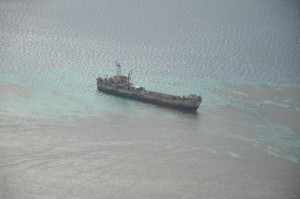 |
 |
|
AFP Western Command resupplies this station by sea and by air. These missions are performed on a regular schedule, and the station itself is stocked with supplies to accommodate unexpected delays that, in the past, have doubled the tours of duty of the Marines guarding the ship.
Troop rotations are performed by boat. For Operational Security (OPSEC) reasons, exactly how resupply boats reach the station despite the Chinese blockade will not be discussed here.
Consumables and care packages, on the other hand, can be air dropped to the ship. Items are placed in sacks which are then enclosed in plastic along with bouyancy aids such as styrofoam. These are then dropped in the water beside the the outpost and the resident Philippine Marines simply bring them onboard. See inset on the photo below on the right.
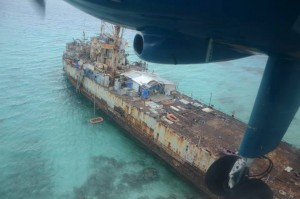 |
 |
||
| Logistic air drop. Photo c/o Philippine Navy | Philippine Navy islander dropping cargo. Photo c/o Philippine Air Force |
To summarize the state of logistic affairs on Ayungin, existing techniques allow for either slow transport of large quantities of personnel and provisions, or rapid delivery of modest quantities of supplies. Neither method, however, can be used for rapid extraction of men or materiel. Which also means that neither method would be suitable for Medical Evacuation (MEDEVAC) missions. If AFP personnel on these outposts ever fall seriously ill or are injured, they will be in for a long wait before they can be given proper medical care.
Heli-deck equipped vessels, such as the Del Pilar class frigates, Frank Besson LSVs, even Philippine Coast Guard Tenix boats, could presumably dispatch helicopters to recover a stricken individual from the outpost. Rotary-wing aircraft could fly over any Chinese blockading ships to reach their destinations. But the ships would still have to travel to within helicopter-flying distance to be effective. Furthermore, the medical facilities on these ships are limited — none are normally equipped for tertiary care. Once the patient is onboard, they would still have to sail at best possible speed to an alternative medical facility.
Seaplanes and flying boats would be the logical choice for the MEDEVAC role, as they are the only aircraft that can embark passengers from WPS outposts, and travel with sufficient speed back to air bases in Palawan, Metro Manila or at the very least to the medical health center on Pag-asa island.
These aircraft could also be used to satisfy the MEDEVAC needs of Philippine Navy and Philippine Coast Guard ships on patrol or remote island communities in other parts of the Philippines. While acquired primarily for a military purpose, it has windfall benefits for the general population.
This is an operational challenge that needs a solution. The defenders of the West Philippine Sea deserve nothing less than the country’s best effort in ensuring access to medical treatment within the all-important Golden Hour, during which medical intervention will yield the most benefit. Philippine Navy or Philippine Air Force floatplanes, whichever service gets them first, offer the best means for satisfying this need.
 |
About this article
The base research for this article was completed in 2006, as part of back-end work for the following thread on the Timawa.net forum: Operating Seaplanes.